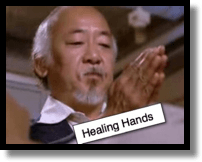Nursemaid’s Elbow – feel like Mr. Miyagi
Nursemaid’s elbow: honestly, this may be the single most enjoyable condition to treat. Yes, we all do a lot of fantastic feats daily to help improve the health and well-being of children, but I would argue that few are as instantaneously rewarding as using your bare hands to completely alleviate a child’s (and his/her family’s) distress. It makes you feel like Mr. Miyagi!
Presentation
- Radial head subluxation is VERY common; most often seen in ages of 1-4 yrs.
- Typically, the arm is held close to the body with elbow flexed and forearm in pronation.
Management
- If the history and physical are classic, no X-rays are needed. Obtain x-rays if there is significant swelling or the story is not classic.
- Two Methods:
- See Larry Mellick’s useful Video!
- HyperPronation Technique
- Hold elbow at 90 degrees or extended.
- Position one hand over elbow with thumb over radial head.
- Firmly hyperpronate the forearm.
- Supination Technique
- With arm held at 90 degrees position hand over elbow with thumb over radial head.
- Firmly supinate the forearm.
- While maintaining pressure over radial head and forearm in supination, flex the elbow completely.
- Both techniques have proven to be efficacious. The Hyperpronation technique has literature that seems to favor it as being easier to do, more successful initially, and less discomfort for the child (again, the child often starts with the arm already partially in pronation).
- Post-reduction
- Immobilation is not necessary for 1st episode generally.
- The time from successful reduction to normal use is typically longer in younger children and in those who have been subluxed longer.
- If delayed reduction (>12 hours), place in long arm posterior splint in full supination and elbow @90 degrees
My Humble Thoughts:
– Don’t be mean… give the kid some analgesic.
– Don’t fret over which technique is most superior… they both work well, so if one doesn’t work… try the other one. Usually, I’ll start with the hyperpronation, merely because the position of the arm initially makes easier to attempt.
– Right after you make the reduction attempt, find an ice-pop as another “analgesic” and a way to test the success of your reduction.
– Keep your differential open. If the first and second attempts don’t work, you can try again, but after the fourth time, it is time to consider other injuries.
http://www.wheelessonline.com/ortho/nursemaids_elbow_radial_head_subluxation
Krul M, Van Der Wouden JC, Van Suijlekom-Smit LW, Koes, BW. Manipulative interventions for reducing pulled elbow in young children. Cochrane Database of Systematic Reviews. 2009;4.
Macias CG, Bothner J, Wiebe R. A comparison of supination/flexion to hyperpronation in the reduction of radial head subluxations. Pediatrics. Jul 1998;102(1):e10.
Green DA, Linares MYR, Garcia P, Greenberg B, Bakery RL. Randomized comparison of pain perception during radial head subluxation reduction using supination-flexion or forced pronation. Pediatric Emergency Care. April 2006;22:235-238.
Bek D, Yildiz C, Kose O, Sehirlioglu A, Basbozkurt M. Pronation versus supination maneuvers for the reduction of ‘pulled elbow’: a randomized clinical trial. Eur J Emerg Med. Jun 2009;16(3):135-138.



[…] are able to make a patient actually feel better! Sometimes that is by simple acts (like treating a Nursemaid’s elbow or removing a Nasal Foreign Body) and other times it is through more exotic means (like […]